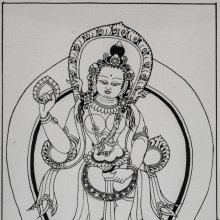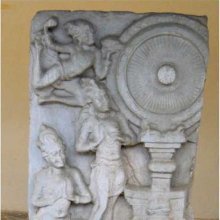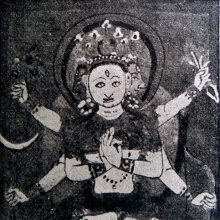Dharmacakra, Dharma-cakra: 22 definitions
Introduction:
Dharmacakra means something in Buddhism, Pali, Hinduism, Sanskrit, Jainism, Prakrit, the history of ancient India. If you want to know the exact meaning, history, etymology or English translation of this term then check out the descriptions on this page. Add your comment or reference to a book if you want to contribute to this summary article.
Alternative spellings of this word include Dharmachakra.
Images (photo gallery)
(+20 more images available)
In Hinduism
Purana and Itihasa (epic history)
Source: Cologne Digital Sanskrit Dictionaries: The Purana IndexDharmacakra (धर्मचक्र).—Also Sunābha, was set in motion and the place where its spokes were thrown out was spotted as the sacred place fit for seers; it fell in the Naimiṣa region.*
- * Brahmāṇḍa-purāṇa I. 2. 8; Vāyu-purāṇa 1. 183; 2. 8.

The Purana (पुराण, purāṇas) refers to Sanskrit literature preserving ancient India’s vast cultural history, including historical legends, religious ceremonies, various arts and sciences. The eighteen mahapuranas total over 400,000 shlokas (metrical couplets) and date to at least several centuries BCE.
Dhanurveda (science of warfare)
Source: Wisdom Library: DhanurvedaDharmacakra (धर्मचक्र) refers to a weapon (a mythical weapon). It is a Sanskrit word defined in the Dhanurveda-saṃhitā, which contains a list of no less than 117 weapons. The Dhanurveda-saṃhitā is said to have been composed by the sage Vasiṣṭha, who in turn transmitted it trough a tradition of sages, which can eventually be traced to Śiva and Brahmā.

Dhanurveda (धनुर्वेद) refers to the “knowledge of warfare” and, as an upaveda, is associated with the Ṛgveda. It contains instructions on warfare, archery and ancient Indian martial arts, dating back to the 2nd-3rd millennium BCE.
Shilpashastra (iconography)
Source: Shodhganga: The significance of the mūla-beras (śilpa)Dharmacakra (धर्मचक्र) or Dharmacakrahasta refers to “Buddha” and represents one of the four gestures with both hands, as defined according to texts dealing with śilpa (arts and crafs), known as śilpaśāstras.—Accordingly, pratimā-lakṣaṇa (body postures of the icons) is comprised of hand gestures (hasta, mudrā or kai-amaiti), stances/poses (āsanas) and inflexions of the body (bhaṅgas). There are thirty-two types of hands [viz., dharmacakra-hasta] classified into two major groups known as tolirkai (functional and expressive gestures) and elirkai (graceful posture of the hand).

Shilpashastra (शिल्पशास्त्र, śilpaśāstra) represents the ancient Indian science (shastra) of creative arts (shilpa) such as sculpture, iconography and painting. Closely related to Vastushastra (architecture), they often share the same literature.
In Buddhism
Mahayana (major branch of Buddhism)
Source: Wisdom Library: Maha Prajnaparamita SastraDharmacakra (धर्मचक्र) refers to the “Wheel of Dharma”, according to an appendix at the 2nd century Mahāprajñāpāramitāśāstra chapter 51.—The Wheel of the Dharma (dharmacakra) is of three turnings and twelve aspects.
The first turning (parivarta) of the noble Truths is the Path of seeing (darśanamārga) and consists of four aspects (ākāra):
- This is suffering (idaṃ duḥkham);
- This is its origin (ayaṃ samudayaḥ);
- This is its cessation (ayaṃ nirodhaḥ);
- This is the path of the cessation of suffering (iyaṃ nirodhagāminī pratipat).
The second turning is the path of meditation (bhāvanāmārga) and consists of four aspects:
- The noble truth of suffering should be known (duḥkhaṃ āryasatyaṃ parijñeyam);
- Its origin should be eliminated (duḥkhasamudayaḥ prahātavyaḥ);
- Its destruction should be realized (duḥkhanirodhaḥ sākṣātkartavyaḥ);
- The path of cessation of suffering should be practiced (duḥkhanirodhagāminī pratipad bhāvayitavyā).
The third turning is the path of the Arhat (aśaikṣamārga) and consists of four aspects:
- Suffering is known (duḥkhaṃ parijñātam);
- Its origin has been destroyed (samudayaḥ prahīṇaḥ);
- Its destruction has been realized (nirodhaḥ sākṣātkṛtaḥ);
- The path of the cessation of suffering has been practiced (duḥkhanirodhagāminī pratipad bhāvitā).
Dharmacakra (धर्मचक्र) refers to the “wheel of the dharma”, according to the Gaganagañjaparipṛcchā: the eighth chapter of the Mahāsaṃnipāta (a collection of Mahāyāna Buddhist Sūtras).—Accordingly, as Bodhisattva Gaganagañja explains to Bodhisattva Ratnaśrī what kind of concentration should be purified: “[...] (37) [when the Bodhisattvas attain] the concentration called ‘Entering into appearance’, all objective supports will be purified; (38) [when the Bodhisattvas attain] the concentration called ‘Being free from depravity’, they will transcend all objective supports; (39) [when the Bodhisattvas attain] the concentration called ‘Stainless wheel’, the wheel of the dharma will be purified (dharmacakra); [...]”.

Mahayana (महायान, mahāyāna) is a major branch of Buddhism focusing on the path of a Bodhisattva (spiritual aspirants/ enlightened beings). Extant literature is vast and primarely composed in the Sanskrit language. There are many sūtras of which some of the earliest are the various Prajñāpāramitā sūtras.
Tibetan Buddhism (Vajrayana or tantric Buddhism)
Source: archive.org: The Indian Buddhist IconographyDharmacakra (धर्मचक्र) or Dharmacakralokeśvara refers to number 81 of the 108 forms of Avalokiteśvara found in the Machhandar Vahal (Kathmanu, Nepal). [Machhandar or Machandar is another name for for Matsyendra.].
Accordingly,—
“Dharmacakra again is similar to [Piṇḍapātra Lokeśvara], except that here he carries the Vajra in his right hand and the axe in his left.—Piṇḍapātra Lokeśvara is one-faced and two-armed and stands on a lotus. He holds the Piṇḍapātra (the bowl) in his two hands near the navel”.
The names of the 108 deities [viz., Dharmacakra] possbily originate from a Tantra included in the Kagyur which is named “the 108 names of Avalokiteshvara”, however it is not yet certain that this is the source for the Nepali descriptions.Source: OSU Press: Cakrasamvara Samadhi
Dharmacakra (धर्मचक्र) is the name of a Cakra (sacred centre [?]) [i.e., oṃ dharmacakrāya svāhā], according to the Vāruṇī Pūjā [i.e., Varuni Worship] ritual often performed in combination with the Cakrasaṃvara Samādhi, which refers to the primary pūjā and sādhanā practice of Newah Mahāyāna-Vajrayāna Buddhists in Nepal.

Tibetan Buddhism includes schools such as Nyingma, Kadampa, Kagyu and Gelug. Their primary canon of literature is divided in two broad categories: The Kangyur, which consists of Buddha’s words, and the Tengyur, which includes commentaries from various sources. Esotericism and tantra techniques (vajrayāna) are collected indepently.
General definition (in Buddhism)
Source: WikiPedia: BuddhismOne of the Eight Auspicious Symbols
The Dharmacakra is a symbol that has represented dharma, the Buddhas teaching of the path to enlightenment, since the early period of Indian Buddhism. It is also sometimes translated as wheel of doctrine or wheel of law. A similar symbol is also in use in Jainism. It is one of the Ashtamangala Symbols.
Source: SOAS Research Online: The Buddhist boundary markers of northeast Thailand and central LaosThe dharmacakra or Wheel of the Law has been an integral part of Buddhist iconography from its earliest representations in India until the present day. It symbolises the moment Sakyamuni put into motion the teachings of Buddhism at the deer park in Sarnath. It was this event that in effect started the entire Buddhist religious and monastic movement.
The dharmacakra is made up of two to three distinct parts. Firstly there is the cakra (wheel) itself which is shown with spokes radiating out from the centre to the rim. The spokes can vary in number from anywhere between four and twenty. The cakra is at times mounted on a stambha (pillar).
In Jainism
General definition (in Jainism)
Source: archive.org: The Jaina IconographyDharmacakra (धर्मचक्र) (“wheel of law”) seems to have been borrowed from Buddhism to indicate the preaching of the Dharma in connection with the Tīrthaṅkaras.
Source: CrossAsia-eJournals: The Āyāgapaṭas of MathuraDharmacakra (धर्मचक्र) or “wheel of law” of was an important object of worship worshipped by Jains. According to the Jain mythology, the first dharmacakra was installed by Bāhubalī, the son of Ṛṣabhanātha (first Tīrthaṅkara). See Jain and Fischer (1978: 7) and Shah (1987: 20).

Jainism is an Indian religion of Dharma whose doctrine revolves around harmlessness (ahimsa) towards every living being. The two major branches (Digambara and Svetambara) of Jainism stimulate self-control (or, shramana, ‘self-reliance’) and spiritual development through a path of peace for the soul to progess to the ultimate goal.
India history and geography
Source: SOAS Research Online: The Buddhist boundary markers of northeast Thailand and central Laos (history)The earliest evidence for the dharmacakra motif comes from the Maurya Period (circa 313-185 BCE). Most examples occur in stone reliefs such as at the sites of Bharhut, Sanci and Amaravati, and in certain instances most likely symbolise aniconic representations of the Buddha. In these early examples the cakra is usually mounted on a stambha. From the 3rd century CE onwards the motif becomes restricted to the bases of Buddha images and signifies the first sermon scene (Brown 1996, 160).
Source: Cologne Digital Sanskrit Dictionaries: Indian Epigraphical GlossaryDharma-cakra.—(CII 3; LL), Buddhist; the wheel of Dharma which was the symbol representing the Buddha on early Buddhist sculptures, on stone inscriptions and on seals attached to copperplate grants. (HA) Jain; the wheel of law supposed to move in the sky in front of a Jina when he goes on his wanderings from place to place; one of the members of the parikara of a Jina image. Note: dharma-cakra is defined in the “Indian epigraphical glossary” as it can be found on ancient inscriptions commonly written in Sanskrit, Prakrit or Dravidian languages.

The history of India traces the identification of countries, villages, towns and other regions of India, as well as mythology, zoology, royal dynasties, rulers, tribes, local festivities and traditions and regional languages. Ancient India enjoyed religious freedom and encourages the path of Dharma, a concept common to Buddhism, Hinduism, and Jainism.
Languages of India and abroad
Pali-English dictionary
Source: BuddhaSasana: Concise Pali-English Dictionarydhammacakka : (nt.) the wheel of Norm.

Pali is the language of the Tipiṭaka, which is the sacred canon of Theravāda Buddhism and contains much of the Buddha’s speech. Closeley related to Sanskrit, both languages are used interchangeably between religions.
Sanskrit dictionary
Source: DDSA: The practical Sanskrit-English dictionaryDharmacakra (धर्मचक्र).—
1) The wheel or range of the law; Bhddh. Jain.
2) a Buddha. °मृत् (mṛt) m. a Buddha or Jaina.
Derivable forms: dharmacakraḥ (धर्मचक्रः).
Dharmacakra is a Sanskrit compound consisting of the terms dharma and cakra (चक्र).
Source: Cologne Digital Sanskrit Dictionaries: Edgerton Buddhist Hybrid Sanskrit DictionaryDharmacakra (धर्मचक्र).—nt. (Sanskrit id., but in [Buddhist Hybrid Sanskrit] as in Pali dhammacakka used in a specialized sense, hardly exactly paralleled in Sanskrit), the wheel of the law, which was ‘set in motion’ (pra-vartayati; pravartana, n.) by the Buddha when he first preached his doctrine: passim; triparivarta- (see parivarta)-dvādaśākāra-dharmacakra-pravartanam Mahāvyutpatti 1309; °kra-pravartana- Lalitavistara 36.3; °kraṃ pravartitaṃ Saddharmapuṇḍarīka 69.13; Divyāvadāna 393.23; °kraṃ pravartesi Saddharmapuṇḍarīka 69.15 (verse), etc.
Source: Cologne Digital Sanskrit Dictionaries: Benfey Sanskrit-English DictionaryDharmacakra (धर्मचक्र).—n. the law, Mbh 2, 456.
Dharmacakra is a Sanskrit compound consisting of the terms dharma and cakra (चक्र).
Source: Cologne Digital Sanskrit Dictionaries: Monier-Williams Sanskrit-English Dictionary1) Dharmacakra (धर्मचक्र):—[=dharma-cakra] [from dharma > dhara] n. the wheel or range of the law, [Mahābhārata; Buddhist literature; Jaina literature]
2) [v.s. ...] a [particular] mythical weapon, [Harivaṃśa; Rāmāyaṇa]
3) [v.s. ...] m. ‘having or turning the wh° of the l°’, a Buddha, [cf. Lexicographers, esp. such as amarasiṃha, halāyudha, hemacandra, etc.]
Source: Cologne Digital Sanskrit Dictionaries: Yates Sanskrit-English DictionaryDharmacakra (धर्मचक्र):—[dharma-cakra] (kraḥ) 1. m. A Jaina sage.
[Sanskrit to German]
Sanskrit, also spelled संस्कृतम् (saṃskṛtam), is an ancient language of India commonly seen as the grandmother of the Indo-European language family (even English!). Closely allied with Prakrit and Pali, Sanskrit is more exhaustive in both grammar and terms and has the most extensive collection of literature in the world, greatly surpassing its sister-languages Greek and Latin.
Kannada-English dictionary
Source: Alar: Kannada-English corpusDharmacakra (ಧರ್ಮಚಕ್ರ):—
1) [noun] an empire where special care is given for nurturing, developing and promoting, religious, moral and social virtues.
2) [noun] Viṣṇu, who protects righteousness in the world.
3) [noun] the Buddha.
4) [noun] the sacred wheel, the symbol of Buddhism.
5) [noun] the resplendent mythological wheel, having one thousand spokes, of a Tīrthaṃkara, any of the twenty four Jaina spiritual teachers.
6) [noun] he who wears a circular, wheel-like ornament.
Kannada is a Dravidian language (as opposed to the Indo-European language family) mainly spoken in the southwestern region of India.
See also (Relevant definitions)
Partial matches: Dharma, Cakra, Tarma.
Starts with: Dharmacakrabhrit, Dharmacakracandrodgatashri, Dharmacakrahasta, Dharmacakrajvalanateja, Dharmacakralokeshvara, Dharmacakramudra, Dharmacakranirghoshagaganameghapradiparaja, Dharmacakranirmanaprabha, Dharmacakranirmanasamantapratibhasanirghosha, Dharmacakraprabhanirghosha, Dharmacakraprabhanirghosharaja, Dharmacakrapravartaka, Dharmacakrapravartana, Dharmacakravala.
Full-text (+76): Dharmacakrabhrit, Dharmacakrapravartana, Pratyeshita, Anupravartayati, Pancagandaka, Abhisarga, Dharmmacakrabhrit, Dharmacakramudra, Avaivartya, Avaivarttika, Pravartanata, Ujjayini, Mahalakshmi, Jvalamukhi, Siddhasimbhali, Mahili, Prayagi, Devikoti, Kaumaripauriki, Gacchantaka.
Relevant text
Search found 25 books and stories containing Dharmacakra, Dharma-cakra; (plurals include: Dharmacakras, cakras). You can also click to the full overview containing English textual excerpts. Below are direct links for the most relevant articles:
Amaravati Art in the Context of Andhra Archaeology (by Sreyashi Ray chowdhuri)
Buddhapāda worship < [Chapter 3 - Amarāvatī and the Formative Stage of the Buddhist Art]
The Dhamma Wheel < [Chapter 3 - Amarāvatī and the Formative Stage of the Buddhist Art]
The first Sermon or Dharmacakrapravartana < [Chapter 3 - Amarāvatī and the Formative Stage of the Buddhist Art]
Maha Prajnaparamita Sastra (by Gelongma Karma Migme Chödrön)
Part 13 - Carrying out abhisaṃbodhi, preaching and conversions all in the same day < [Chapter LI - Seeing all the Buddha Fields]
Appendix 1 - The three turnings and twelve aspects of the Wheel of Dharma < [Chapter LI - Seeing all the Buddha Fields]
Appendix 5 - Definition of Brahmacarya and Brahmacakra < [Chapter XIV - Emission of rays]
The Indian Buddhist Iconography (by Benoytosh Bhattachacharyya)
108 forms of Avalokiteśvara (81): Dharmacakra Lokeśvara
Figure 83-86 - Mañjuśrī Mañjuvara
The Buddha (by Piyadassi Thera)
Abhinaya-darpana (English) (by Ananda Coomaraswamy)
Plate VII - Hands of Images < [Plates]
The gods of northern Buddhism (by Alice Getty)





